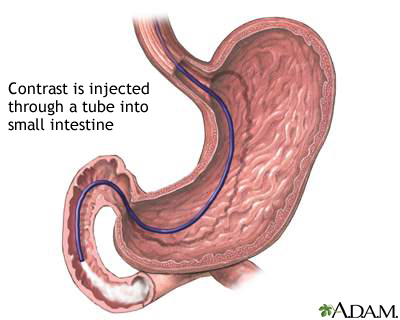Health Library
Enteroclysis
Small bowel enema; CT enteroclysis; Small bowel follow-through; Barium enteroclysis; MR enteroclysis
Enteroclysis is an imaging test of the small intestine. The test looks at how a liquid called contrast material moves through the small intestine.
Images

I Would Like to Learn About:
How the Test is Performed
This test is done in a radiology department. Depending on the need, x-ray, CT scan, or MRI imaging is used.
The test involves the following:
- Your health care provider inserts a tube through your nose or mouth into your stomach and into the beginning of the small bowel.
- Contrast material and air flow through the tube, and images are taken.
The provider can watch on a monitor as the contrast moves through the bowel.
The goal of the study is to view all of the loops of small bowel. You may be asked to change positions during the exam. The test may last a few hours, because it takes a while for the contrast to move through all of the small bowel.
How to Prepare for the Test
Follow your provider's instructions on how to prepare for the test, which may include:
- Drinking clear liquids for at least 24 hours before the test.
- Not eating or drinking anything for several hours before the test. Your provider will tell you exactly how many hours.
- Taking laxatives to clear the bowels.
- Not taking certain medicines. Your provider will tell you which ones. Do not stop taking any medicines on your own. Ask your provider first.
If you are anxious about the procedure, you may be given a sedative before it starts. You will be asked to remove all jewelry and wear a hospital gown. It is best to leave jewelry and other valuables at home. You will be asked to remove any removable dental work, such as appliances, bridges, or retainers.
If you are, or think you're pregnant, tell your provider before the test.
How the Test will Feel
The placement of the tube may be uncomfortable. The contrast material may cause a feeling of abdominal fullness.
Why the Test is Performed
This test is performed to examine the small bowel. It is one way of telling if the small intestine is normal.
Normal Results
There are no problems seen with the size or shape of the small intestine. Contrast travels through the bowel at a normal rate without any sign of blockage.
What Abnormal Results Mean
Many problems of the small intestine can be found with enteroclysis. Some of these include:
- Inflammation of the small bowel (such as Crohn disease)
- Small bowel isn't absorbing nutrients normally (malabsorption)
- Narrowing or stricture of the intestine
- Small bowel blockage
- Tumors of the small intestine
Risks
The radiation exposure may be greater with this test than with other types of x-rays because of the length of time. But most experts feel that the risk is low compared to the benefits.
Pregnant women and children are more sensitive to the risks of x-ray radiation. Rare complications of enteroclysis include:
- Allergic reactions to medicines prescribed for the test (your provider can tell you which medicines)
- Possible injury to bowel structures during the study
Barium may cause constipation. Tell your provider if the barium has not passed through your system by 2 or 3 days after the test, or if you feel constipated.
Related Information
X-rayMalabsorption
Intestinal obstruction and Ileus
Crohn disease
Upper GI and small bowel series
Barium enema
References
Al Sarraf AA, McLaughlin PD, Maher MM. The small intestine, mesentery and peritoneal cavity. In: Adam A, Dixon AK, Gillard JH, Schaefer-Prokop CM, eds. Grainger & Allison's Diagnostic Radiology. 7th ed. Philadelphia, PA: Elsevier; 2021:chap 21.
Thomas AC. Imaging the small bowel. In: Sahani DV, Samir AE, eds. Abdominal Imaging. 2nd ed. Philadelphia, PA: Elsevier; 2017:chap 24.
BACK TO TOPReview Date: 5/29/2024
Reviewed By: Debra G. Wechter, MD, FACS, General Surgery Practice Specializing in Breast Cancer, Virginia Mason Medical Center, Seattle, WA. Also reviewed by David C. Dugdale, MD, Medical Director, Brenda Conaway, Editorial Director, and the A.D.A.M. Editorial team.
 | A.D.A.M., Inc. is accredited by URAC, for Health Content Provider (www.urac.org). URAC's accreditation program is an independent audit to verify that A.D.A.M. follows rigorous standards of quality and accountability. A.D.A.M. is among the first to achieve this important distinction for online health information and services. Learn more about A.D.A.M.'s editorial policy, editorial process and privacy policy. A.D.A.M. is also a founding member of Hi-Ethics. This site complies with the HONcode standard for trustworthy health information: verify here. |
The information provided herein should not be used during any medical emergency or for the diagnosis or treatment of any medical condition. A licensed medical professional should be consulted for diagnosis and treatment of any and all medical conditions. Links to other sites are provided for information only -- they do not constitute endorsements of those other sites. No warranty of any kind, either expressed or implied, is made as to the accuracy, reliability, timeliness, or correctness of any translations made by a third-party service of the information provided herein into any other language. © 1997- 2024 A.D.A.M., a business unit of Ebix, Inc. Any duplication or distribution of the information contained herein is strictly prohibited.
